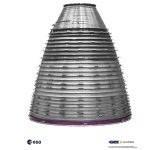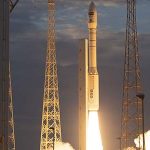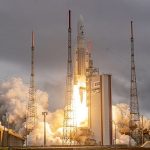Can reusable rockets bring down launch costs enough to meet growing market needs and create wider access to space? Keith J Fernandez investigates.
 Recycling is perhaps the most pervasive buzzword on earth. But can it be extended to our activities in space? More players in the satellite and rocket industries are beginning to think so, not least because of recent successes. Maverick engineer Burt Rutan, the designer behind projects such as SpaceShipOne and White Knight One, framed the problem succinctly in a 2012 interview with The Economist: Space travel is the only technology that is ESA dangerous and more expensive now than it was in its first year. Fifty years after Yuri Gagarin, the space shuttle ended up being more dangerous and more expensive to fly than those first throwaway rockets, even though large portions of it were reusable. Its absurd. Thats changing as a slew of companies race to build reusable launch vehicles and stages. Rockets have traditionally been expensive, single-use vehicles that are discarded after launching a satellite into space. Not only is this approach costly, but it is also wasteful. As more satellites and rockets are sent up, space operations must become cheaper, more efficient and more sustainable.
Recycling is perhaps the most pervasive buzzword on earth. But can it be extended to our activities in space? More players in the satellite and rocket industries are beginning to think so, not least because of recent successes. Maverick engineer Burt Rutan, the designer behind projects such as SpaceShipOne and White Knight One, framed the problem succinctly in a 2012 interview with The Economist: Space travel is the only technology that is ESA dangerous and more expensive now than it was in its first year. Fifty years after Yuri Gagarin, the space shuttle ended up being more dangerous and more expensive to fly than those first throwaway rockets, even though large portions of it were reusable. Its absurd. Thats changing as a slew of companies race to build reusable launch vehicles and stages. Rockets have traditionally been expensive, single-use vehicles that are discarded after launching a satellite into space. Not only is this approach costly, but it is also wasteful. As more satellites and rockets are sent up, space operations must become cheaper, more efficient and more sustainable.
Companies like SpaceX and Blue Origin, among those sending the most rockets to space, are leading the charge for total or near-total reusability by designing rockets that can be recovered and relaunched, as they look to rationalise operations costs first and foremost and improve sustainability as a second imperative. Reusable rockets are seen today as the solution for lowering the launch and transportation cost, so in the next five to ten years all operators will move in this direction if they want to stay in the market, says Walter Cugno, Vice President Exploration and Science at Thales Alenia Space.
The players behind reusable rockets
In May, Thales Alenia Space and the Exploration Company in Germany were selected by the European Space Agency (ESA) to develop a re-entry cargo spaceship. The LEO Cargo Return service is designed to transport cargo to and from Low Earth Orbit (LEO). The contracts are valued at 75m US $81m, Euractiv reported, and will cover deliveries to the International Space Station (ISS). The company has been working on reusability for a while, with projects including the Intermediate Experimental Vehicle (IXV), the free-flying orbital platform Space Rider, and most recently, the REV1 floating space factory. Being one of the major companies worldwide in the space exploration field, Thales Alenia Space has, of course, medium- to long-terms goals for developing strong transportation capability to support growing utilisation on LEO, the moon and beyond. Among other objectives regarding manned and robotic exploration domain, mastering space transportation and logistics is one of our major goals. So, in this field, different types of vehicles are under- development by our company, Cugno says. These systems are of course developed with a strong objective of being sustainable. Sustainability is one of the major goals of Thales Alenia Space.

Space Xs Falcon 9 is perhaps the most well-known reusable rocket, with 293 reflights of a total 361 launches. Each Falcon 9 booster can be reused over 10 times, the first one being in 2017. SpaceX is also focused on increasing the frequency of its fully reusable Starship launches (with four complete as of mid-August) as it aims to make space travel as routine as air travel. Blue Origins fully reusable New Shepard rocket designed for operational reusability and minimal maintenance between flights, has finished 25 missions, recently resuming crewed suborbital trips. Its New Glenn ship is expected to debut this month. Rocket Lab is taking a more incremental approach with its Electron rocket, the worlds first reusable small rocket, featuring 3D-printed engines. It has had eight launches so far. Satellite launch powerhouse ArianeGroup is also looking at reusability despite much smaller volumes. Its proposed Susie rocket, designed to be a fully reusable spacecraft could be available for cargo operations by 2028. Subsidiary MaiaSpace is developing a reusable small rocket, designed to be capable of delivering around 500kg to LEO. An inaugural flight is planned for 2025. The following year could see the first fully 3D-printed reusable rocket from California-based Relativity Space. Its Terran R aims to meet the needs of government and commercial customers are looking to launch satellites quickly and inexpensively, without waiting for a ride share slot on a large rocket launch to become available. In addition, at least four Chinese aerospace companies are also aiming at reusability, including the China Aerospace Science and Technology Corp, the China Academy of Launch Vehicle Technology, a start-up called iSpace and Space Pioneer with its Tianlong 3 rocket.
A look at launch dynamics
Theres certainly an impressive appetite for launches. Research from consulting firm Quilty Space predicts that around 20,000 new satellites will launch successfully by the end of the decade as compared to 487,000 planned government and commercial missions. Low Earth Orbit (LEO) accounts for the majority of new launches broadband mega-constellations account for 85% of all satellite demand in Western markets, it says. By contrast, there were 223 orbital launches in 2023, of which 211 were successful. Thats up from 186 (178 successes) in 2022. There were only 85 attempts less than a decade ago in 2016. Dallas Kasaboski, Principal Analyst at Analysys Mason, which tracks satellite market intelligence through its Norther Sky Research (NSR) subsidiary, describes the launch market as a very big opportunity, principally because of the great volume of satellites that are looking to be launched in the next decade. From our perspective, we forecast that the total revenue opportunity for satellite launch over the 10 years between 2023 and 2033 is just over US$201bn, he tells SatellitePro. Its roughly about $18bn a year, fluctuating over the decade, he adds.

The case for reusability
Reusable rockets could address key space industry challenges around cost efficiency, environmental sustainability, and operational flexibility. As against the traditional high cost of manufacturing and launching new rockets and satellites, reusable rockets lower the barriers to entry, allowing for more frequent launches, including from new players. Refurbishing and relaunching a rocket is up to 65% cheaper than building a new vehicle, according to some estimates with a 30x lower cost overrun. They use less fuel, which also adds to their environmental appeal. SpaceX director of vehicle integration Christopher Couluris mentioned last year that the Falcon 9 costs $28m to launch, thanks to reusability. List prices are $69m. This adaptability is particularly valuable for LEO constellations, where ongoing maintenance and upgrades are crucial. The need to have the capability for transporting and returning cargo from Earth to LEO and vice versa is becoming a key factor for potential operators and users, says Cugno, citing growth projections for the orbit and the development of replacement programmes after the ISS ceases operations in 2030. Having reusable spacecraft will support cost reduction of the service as well as the overall logistics.
From an environmental perspective, theres the issue of debris, and carbon emissions. There are now some 132m pieces of space debris objects littering the skies above us, according to the European Space Agency. Reusing rockets cuts down on the need for new launches, reducing the carbon footprint from manufacturing and fuel consumption. Fewer objects in space also means fewer debris. Then theres speed. Time to launch drops with reusable rockets not just because costs are lower, but because maintenance is easier. This allows for quicker, more frequent satellite deployments.
The pressing need for reliability

All those advantages notwithstanding, reliability remains the most important factor when it comes to launches, Kasaboski says. Your vehicle needs to work and needs to be proven reliable. Cost is only the second consideration, with availability of launch slots following. A customer might initially choose to launch with SpaceX because of its volume of success, but they may eventually cancel or go elsewhere if the operators schedule doesnt meet their desired timeframe as happened in the case of Japanese billionaire and Zozo founder Yusaku Maezawas Dear Moon project. For the greatest traction to happen in the market, reusability needs to affect reliability, cost or schedule.
Sustainability to stakeholders has yet to become a major reason for customers to prioritise reusable rockets. That said, sustainability may be a key consideration for customers with deeper pockets and pressing environmental concerns for example, certain government organisations. Reusable spacecraft have so far focused on cost considerations. NASA, for example, initially wanted a fully reusable rocket for the moon landing in 1969, but the plan for reusable solid rocket boosters was derailed by their high costs.
A quarter of launch market
As of mid-August, SpaceX had 6,336 satellites in orbit to power its Starlink internet service. Of these, 6269 are working. A total of 6,895 were launched, according to astronomer and astrophysicist Jonathan McDowell, who tracks the mega constellation. The company hopes to eventually have 42,000 Starlink satellites in orbit. At those volumes, reusing launch vehicles makes sense. But even without Starlink, SpaceX dominates the satellite launch market with its competitive pricing. Depending on whether you count the internet constellation or not, the company accounts for between 43% and 70% of all satellites launched over the past three years, Kasaboski says. NSR does not break out data on reusable launch vehicles, but they are likely to comprise a quarter of the market, he says, making an early assessment that needs due diligence. Thats being conservative. Its probably actually higher than that, he says. And that percentage is going to throw, because most players in the market are looking at developing a reusable vehicle.
The challenges of reliability remain
Before we get there, however, theres the vexing issue of technical challenges to full reusability. Despite the technical advancements so far, there remain a number of hurdles to be overcome. As Thales Cugno points out, much more needs to happen for fully reusable rockets to become standard. A change in this direction can only happen if new launch or transportation solutions and relevant technologies are found, making the system much more competitive. As of today, there is not yet a different solution in the horizon in this short period of time, he says.
In April 2023, SpaceXs Starship prototype exploded because of an engine malfunction. A few months later, another engine issue hit Blue Origins BE-4 during acceptance testing. People assume that Starship is going to succeed, but that isnt necessarily true, Zack Cordero, the Esther and Harold E. Edgerton Career Development Assistant Professor of Aeronautics and Astronautics at the Massachusetts Institute of Technology, says in a statement. There is a real, underappreciated risk that these new heavy lift launch vehicles will continue to fail unless there are fundamental advances in materials technology, he adds.

Most challenges revolve around reliability, including structural integrity and thermal management. Then, reusable rockets must also integrate components and design elements that enable soft, precise landing and docking. There are also propulsion and fuel efficiency challenges. And thats in addition to environmental concerns include managing emissions and space debris. His research tackles the reliability problem, focusing on extending the lifespan of reusable rockets, while simultaneously reducing the risk of catastrophic failure. His Cordero Lab is working on ignition-resistant materials, oxygen-rich turbopumps and additive manufacturing (or 3D printing) structures, among other solutions. Nevertheless, reusability will be a game-changer.
The new class of reusable launch vehicles is likely to transform the space industry by lowering launch costs and improving space accessibility. This will enable applications such as mega constellations for space-based internet and space-based sensing for things like persistent, real-time CO2 emissions monitoring, he says. And of course, NASA. The space agency remains keen on reusability for lunar missons. It plans to use Starship for its crewed Artemis missions to the moon.













































































